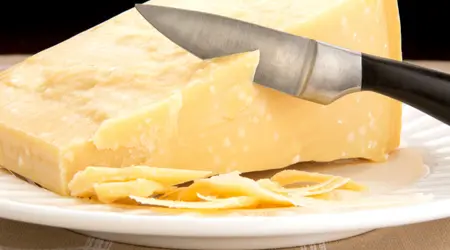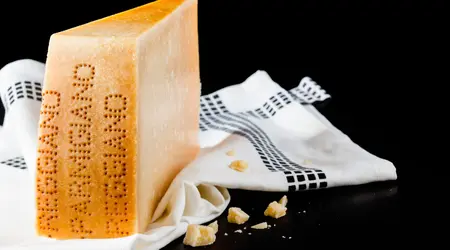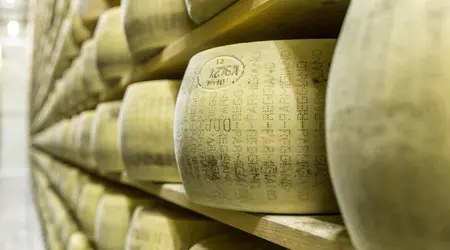Parmigiano Reggiano: How to Recognize the Original and Use It in the Kitchen
The Parmigiano Reggiano It is not just a cheese, but a symbol of Italian tradition, craftsmanship, and quality.
Announcements
Recognizing the original and knowing how to use it in the kitchen means not only appreciating its unique flavor, but also respecting a centuries-old history rooted in the hills of Emilia-Romagna.
In this article, we'll explore how to identify real Parmigiano Reggiano, distinguishing it from imitations, and how to enhance it in the kitchen with creative and intelligent approaches.
Are you ready to discover why this cheese is considered the “king of cheeses”?
How to Recognize Real Parmigiano Reggiano

The Importance of the DOP Brand
Parmigiano Reggiano is a product made from Protected Designation of Origin (PDO), which means that it can only be produced in specific geographical areas (provinces of Parma, Reggio Emilia, Modena, Bologna west of the Reno and Mantua south of the Po) following strict specifications.
Announcements
++ Beer-Dough Pizza: A Masterpiece of Flavor and Innovation
To recognize the original, the first step is to check for the presence of the branding on the rind: a dotted writing that says "Parmigiano Reggiano" along with the dairy's serial number and the production date.
This brand is a guarantee of authenticity, like a passport that tells the story of each shape.
Without it, the cheese could be an imitation, often generically called “parmesan” abroad, which does not meet the same quality standards.
Visual and Sensory Details
In addition to the brand, original Parmigiano Reggiano is distinguished by unique visual and sensory characteristics.
The rind is hard, golden straw in color, and the internal texture has a granular structure with small white crystals of tyrosine, a sign of natural maturation.
To the touch, the consistency is compact but crumbly, while the aroma is intense, with notes of dried fruit, melted butter and a light herbaceous hint.
A trick to test authenticity?
Try lightly scraping the surface: Parmigiano Reggiano doesn't crumble into a powdery consistency like industrial cheeses, but breaks into irregular flakes.
Furthermore, the flavor is complex, never too salty, with a perfect balance between sweetness and savouriness.
Avoiding Imitation Traps
Imitations of Parmigiano Reggiano are widespread, especially in international markets.
Products such as bagged grated “Parmesan” or pre-packaged cheeses labeled “Italian-style” often contain additives, preservatives, or inferior cheese blends.
According to a report by the Parmigiano Reggiano Consortium, the 70% of cheeses sold as “parmesan” outside Europe does not meet the production criteria of true Parmigiano Reggiano.
To avoid being scammed, only buy whole cheeses or packaged pieces with the DOP mark visible.
Also, be wary of prices that are too low: a 24-month-aged Parmigiano Reggiano shouldn't cost as much as a generic cheese.
Investing in quality means bringing a product that has no equal to your table.
| Characteristic | Original Parmigiano Reggiano | Common Imitations |
|---|---|---|
| Brand | “Parmigiano Reggiano” written in dots on the rind | No generic brands or labels |
| Origin | Only the provinces of Parma, Reggio Emilia, Modena, Bologna, and Mantua | Any origin, often non-Italian |
| Ingredients | Milk, rennet, salt | Possible additives or cheese mixes |
| Consistency | Granular, crumbly, with tyrosine crystals | Powdery or rubbery |
| Price | Medium-high, reflects quality | Often very low |
How to Use Parmigiano Reggiano in Cooking

One Ingredient, a Thousand Facets
Parmigiano Reggiano is like a versatile actor in a movie: it can be the protagonist or an extra that elevates the entire scene.
Its ability to adapt to different preparations makes it an indispensable ally in the kitchen.
Don't just grate it over pasta: Parmigiano Reggiano can enrich complex or simple dishes with its umami flavor.
For example, try creating a pumpkin cream soup with Parmesan crustsCook the crusts in the soup to enhance the flavor, then remove them before blending.
The result is an enveloping cream, with a depth of flavor that transforms a simple dish into a gastronomic experience.
Creative Techniques to Enhance It
To enhance Parmigiano Reggiano, consider its maturation.
An 18-month-old is softer and milkier, perfect for salads or fresh dishes, while a 36-month-old, more intense and grainy, pairs well with structured wines or honey.
An original idea?
Prepare Parmigiano Reggiano baskets to serve appetizers.
Grate the cheese, spread it on a non-stick pan to form thin discs, cook until golden and shape them into an inverted bowl.
Once cooled, fill them with arugula, pear, and walnut salad: the contrast between the crunchiness of the basket and the freshness of the ingredients is striking.
Parmigiano Reggiano can also be used as a base for sauces, such as a cream to accompany grilled meats, melting it with a little cream and black pepper.
Storage and Usage Tips
To keep the flavor of Parmigiano Reggiano intact, store it correctly: wrap the pieces in cling film or baking paper and keep them in the refrigerator at 4-8°C.
Avoid grating it ahead of time, as it quickly loses its flavor. Also, don't throw away the rinds!
They can be used to flavor broths, soups or risottos, as a natural condiment that releases flavor during cooking.
A useful analogy?
Think of Parmigiano Reggiano like a fine wine: each seasoning has its own ideal time and pairing, and poor storage can compromise its character.
Experiment, but with respect for its artisanal nature.
| Seasoning | Characteristics | Ideal Use |
|---|---|---|
| 12-18 months | Soft flavour, notes of fresh milk | Salads, light dishes, grated on pasta |
| 24 months | Balance between sweetness and savouriness | Risottos, baked dishes, platters |
| 36 months and over | Intense, grainy, notes of dried fruit | Pairings with honey, red wines, flakes |
Why Choose Original Parmigiano Reggiano?

A Cultural Heritage
Choosing original Parmigiano Reggiano is not just a question of taste, but also of respect for a tradition that dates back to the Middle Ages.
Produced using techniques passed down for generations, each wheel of Parmigiano Reggiano is the result of artisanal work involving farmers, cheesemakers, and seasoners.
This cheese represents an Italian excellence that, according to the Consortium, generates an annual turnover of over 2.5 billion euros, supporting the local economy and promoting biodiversity through the use of milk from cows fed natural fodder.
By purchasing it, you help preserve a unique cultural heritage.
Nutritional Benefits
Parmigiano Reggiano is not only delicious, but also nutritious.
Rich in calcium, protein, and vitamin B12, it is a highly digestible food thanks to its long maturation, which breaks down proteins into simpler peptides.
It is naturally lactose-free, making it suitable for those with lactose intolerances.
Furthermore, its richness in essential amino acids makes it a valuable addition to balanced diets.
However, its salt content requires moderation for those following low-sodium diets.
Use it wisely: a small amount is enough to transform a dish.
An Investment in Taste
Why choose original Parmigiano Reggiano when alternatives are cheaper? The answer lies in its unparalleled quality.
Imitations cannot replicate the complexity of its flavor nor its versatility.
Furthermore, Parmigiano Reggiano is a long-term investment: a well-stored wheel can last for months, offering endless culinary possibilities.
Whether you use it for a creamy risotto or as the star of a platter, its value goes beyond the price.
It's not just food, but an experience that involves all the senses.
Parmigiano Reggiano: Frequently Asked Questions
| Request | Answer |
|---|---|
| How can you tell if Parmigiano Reggiano is original? | Look for the branding on the rind that says "Parmigiano Reggiano" and verify that it is produced in the DOP provinces. The grainy texture and tyrosine crystals are further clues. |
| Can I freeze Parmigiano Reggiano? | It's not recommended, as freezing alters the texture and flavor. Store it in the refrigerator, tightly wrapped, to preserve its quality. |
| How much Parmigiano Reggiano can I eat per day? | A portion of 30-40 g per day is ideal to appreciate its nutritional benefits without overdoing it with salt. |
| Are the crusts edible? | Yes, the rinds are safe and can be used to flavor broths or soups. Don't eat them raw, as they are very tough. |
| What is the difference between Parmigiano Reggiano and Grana Padano? | Parmigiano Reggiano has stricter regulations, a minimum aging period of 12 months (compared to 9 for Grana), and a more restricted production area. Its flavor is more complex and intense. |
Parmigiano Reggiano: Conclusion
The Parmigiano Reggiano It is much more than a cheese: it is a journey through tradition, quality and versatility.
Recognizing the original means appreciating the work of those who produce it and ensuring an authentic experience in the kitchen.
From flakes on a salad to rinds that enrich a broth, this cheese lends itself to endless interpretations, always with a touch of elegance.
The next time you buy a piece of Parmigiano Reggiano, you're not just buying an ingredient, but a piece of Italian history.
How will you use it to surprise your palate?
